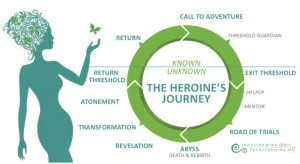The idea that all stories have already been created is an idea that has existed for as long as before the bible was first published. The existance of genres and genre conventions placing expectations and therefore limitations upon films within such genres only forces them to be more confined and ‘cliched’ less they cause an uproar. It’s the way the these ideas are used and placed, and the variation of ideas that can give fresh and new life to seemingly tired and old stories such as vampires and zombies, “a constantly overused plot devise” my mum tells me. But with films like, “A Girl Walks Home Alone at Night” (Amirpour, 2014), an Iranian vampire western, and “Life After Beth” (Baena, 2014), in which a girl becomes a zombie and her boyfriend tries to deal with her new flesh-eating tendencies. These fresh ideas, to me, prove that there is no such thing as no originality, even if the same basic trajectory exists.
This same basic trajectory, which can be found in most films, is known as ‘the hero’s journey’. The hero’s journey, which can also be called the monomyth, follows 12 basic stages and has 7 basic archetypes which are said to be found in most, if not all stories. This idea was created by the American scholar, Joseph Campbell.
The 12 basic stages of the monomyth are:
- THE ORDINARY WORLD
- THE CALL TO ADVENTURE
- REFUSAL OF THE CALL
- MEETING WITH THE MENTOR
- CROSSING THE THRESHOLD
- TESTS, ALLIES AND ENEMIES
- APPROACH
- THE ORDEAL
- THE REWARD
- THE ROAD BACK
- THE RESURRECTION
- RETURN WITH THE ELIXIR – (Unknown)
Of course, not all stories use all the stages, it depends upon the character of the hero, and whether or not their journey is a difficult task and goes against their character, if they need to go through so much indecision and inner turmoil before they start their journey.
One part of the monomyth follows the idea that each great story includes the same 7 archetypal characters:
- Hero
- Herald
- Mentor
- Threshold Guardians
- Trickster
- Shape-Shifter
- Shadow
This video sums up both the character archetypes and the most fundamnetal stages of the hero’s journey:
There is also a lesser known heroine’s journey by Maureen Murdock. It’s stages are slightly similar, but also have a shocking difference – the emphasis on gender. The stages are:
- SEPARATION FROM THE FEMININE
- IDENTIFICATION WITH THE MASCULINE & GATHERING OF ALLIES
- ROAD OF TRIALS, MEETING OGRES & DRAGONS
- FINDING THE BOON OF SUCCESS
- AWAKENING TO FEELINGS OF SPIRITUAL ARIDITY: DEATH
- INITIATION & DESCENT TO THE GODDESS
- URGENT YEARNING TO RECONNECT WITH THE FEMININE
- HEALING THE MOTHER/DAUGHTER SPLIT
- HEALING THE WOUNDED MASCULINE
- INTEGRATION OF MASCULINE & FEMININE, (Unknown)
This journey can be found in some way, shape, or form in films such as “Mulan” (Bancroft and Cook, 1998) and “Brave” (Andrews and chapman, 2012). It is interesting to me how films with female leads seem to have the need for a different model of story telling. However, I don’t think that is quite true anymore. While there will always be stories out there that follow this model, there are also stories breaking this mold and following a stranger more twisted version of the monomyth. Films such as “The Hunger Games” (Ross, 2012) and “Divergent” (Burger, 2014), which are both post-apocolyptic films featuring hardened female leads, and both stories follow the monomyth, not the heroine’s journey. But in saying this, I think it is more the case that both these films are set in a post-apocalyptic future and not the present, so they feel they can show characters who are more hardened due to their situation, regardless of gender, essentially getting rid of classic gender stereotypes because times are too tough to do otherwise.
– Unknown. “Hero’s Journey.” Available at http://www.thewritersjourney.com/hero’s_journey.htm

